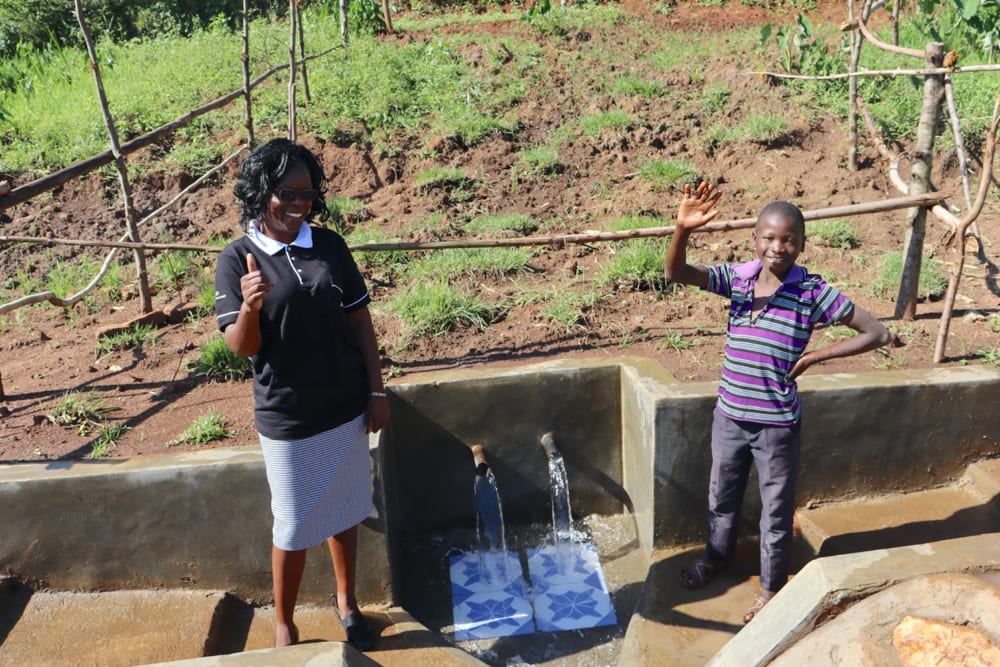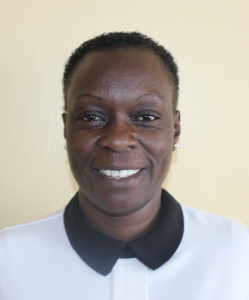December, 2020: Mahira Community, Anunda Spring Project Complete!
Mahira Community now has access to clean water! Anunda Spring has been transformed into a flowing source of water thanks to your donation. We protected the spring, constructed five sanitation platforms for different households in the community, and trained the community on improved sanitation and hygiene practices, including COVID-19 prevention.

Field Officer Mary in the foreground with community members celebrating the completion of Anunda Spring
"I am thrilled because now I take clean and safe water, and it's easier now to fetch water from the spring," said Adelaite Mwombe, who works as a local businessperson.

"I will take a few seconds to fetch water. The water is safe for consumption, and consequently, my health status will greatly improve. The water will be used to water the crops," said Peter Wekesa, a farmer in the community.

Dancing to celebrate clean flowing water
Children were just as excited as the adults about the new water point.
"Time spent fetching water has been shortened. The water is reliable, safe, and of good quality. When the schools open, I will spend less time fetching water after school," said Jane, a young teenager and a primary school student.

Preparing for Spring Protection
Community members worked together to source and carry all locally available construction materials to the spring. These included bricks, sand, stones, and fencing poles. Some people also chiseled away at large stones to break them down into gravel. Because people have to carry most items by hand, the materials collection process can take anywhere from a few weeks to months.
When everything was prepared, we sent a lorry to the community to deliver the rest of the construction materials, including the cement, plastic tarps, and hardware. Then, our artisan and field officers deployed to the spring to begin work. Everyone traveled to and from the work site each day throughout the construction process, so individual households provided meals throughout the day to sustain the workers.

Community members deliver large stones to the spring construction site
The last step before construction commenced was taking a water sample from the unprotected spring. We sent the sample to a government laboratory for testing to identify the kinds of contaminants in the water before its protection. These often include fertilizers and pesticides from farms, animal and human feces, and any number of harmful bacteria. We then shared the test results with the community to identify extra steps they could take to help ensure the spring’s water remains clean and safe after protection.
From Open Source to Protected Spring: A Step-by-Step Process
At last, it was time to dig in at the spring! Women and men lent their strength to the artisan each day to help with the manual labor. First, we cleared and excavated the spring area. We dug a drainage channel below the spring and several surface runoff diversion channels above and around the spring—this help to divert the environmental contaminants identified in the pre-construction water quality test.

Excavation begins
To ensure community members could still fetch water throughout the construction process, we also dug temporary diversion channels from the spring’s eye around the construction site. This allowed water to flow without severely disrupting community members’ water needs or construction work.

Laying the spring foundation
Excavation created space for setting the spring’s foundation made of thick plastic tarp, wire mesh, concrete, and waterproof cement. After setting the base, we started brickwork to build the headwall, wing walls, and stairs.

Brickwork begins
Next, we began one of the most crucial spring protection steps to ensure a fully functional water point: setting the discharge pipe. The discharge pipe has to be set low enough in place in the headwall so that the water level inside never rises above the spring’s eye, yet high enough to leave eighteen to twenty inches between the pipe and the spring floor to allow room for the average jerrycan (a 20-liter container) to sit beneath the pipe without making contact.

Setting the discharge pipe
If the discharge pipe were placed too high above the spring’s eye, too much backpressure could force the flow to emerge elsewhere. Too low, and community members would not be able to access the water easily. We embedded the pipe using clay (or mortar when the clay is in short supply) and placed it at a slight incline to ensure water flows in the right direction.

Drawing point construction
In coordination with brickwork, we pitched medium to large stones on both sides of the spring’s drainage channel. We then cemented and plastered each stone group into place, forming the rub walls. These help to discourage people and animals from trying to stand on that area, which could cause soil erosion and thus a clogged drainage area.

Cement and plaster work on the rub wall, stairs, and spring walls
With brickwork and stone pitching completed, we turned to cement and plaster both sides of the headwall and wing walls. This reinforces the brickwork and prevents water in the reservoir from seeping through the walls. In turn, this builds enough pressure in the reservoir box to push water out through the discharge pipe.

Backfilling with stones
As the headwall and wing walls were curing, we cemented and plastered the stairs and installed four tiles beneath the discharge pipe. The tiles protect the concrete from the falling water's erosive forcer, beautify the spring, and facilitate easy cleaning of the spring floor.

Fitting the tarp
We transitioned to the final stages of construction with the tiles in place - backfilling the reservoir box. First, we cleared the collection box of any debris that may have fallen in since its construction, such as dead leaves or other items. Then we redirected the temporary diversion channels back into the reservoir box, channeling water into this area for the first time. We closed off all of the other exits to start forcing the water through the discharge pipe only.

Fencing and planting grass
With much help from the community, we filled up the reservoir area with the clean and large stones they gathered, arranging them in layers like a well-fitting puzzle. We covered the stones with a thick plastic tarp to minimize potential contamination sources from aboveground, followed by a layer of soil. We piled enough soil on top to create a slight mound to compensate for the backfill’s future settlement.
Community members transplanted grass onto the backfilled soil to help prevent erosion. Finally, the collection area was fenced to discourage any person or animal from walking on it since compaction can lead to disturbances in the backfill layers and potentially compromise water quality.

Completed Anunda Spring
The entire construction process took about two weeks of work and patience to allow the cement and plaster to finish curing. As soon as it was ready, people got the okay from our field officers to fetch water.

Clean water flows from Anunda Spring
We officially handed over the spring directly following training. Happiness, thanksgiving, and appreciation were the order of the day, flowing in all directions. The community members were pleased to see how clean water flows from the protected spring. They sang a song praise song and danced. Finally, the community presented the field officer with a hen as a gift to appreciate the good work done.

Community members celebrate the protected spring
Sanitation Platforms
All five sanitation platforms have been completed and handed over to their new owners. These five families are happy about this milestone of having a private latrine of their own and are optimistic that people will no longer leave waste outdoors. We are continuing to encourage families to finish building walls and roofs over their new latrine floors, and for other families to replicate the design after having helped construct these examples.

Jeremiah stands with his family's new sanitation platform
Training on Health, Hygiene, COVID-19 and More
Due to the ongoing challenges and restrictions amidst the pandemic, we worked with both local leaders and the national Ministry of Health to gain approval for a small group training about health, hygiene, and COVID-19 prevention.
Together with the community, we found the community’s preferred date for training while considering other community calendar events such as the agricultural season and the national coronavirus-related curfew. We requested a select yet representative group of community members to attend training, relaying the information learned to the rest of their family and friends. When the day arrived, facilitators Sam Simidi and Mary Afandi
deployed to the site to lead the event.

Trainer demonstrates the ten steps of handwashing at training.
24 people attended training, including the local Community Health Volunteer. We held the training at one of the community member's homesteads near the spring in the shade of trees.
Perhaps the most important topic of the day was our session on COVID-19 prevention and specific guidance in line with national and international standards. There has been tension and panic about the coronavirus in Kenya, so this was a session everyone eagerly participated in, the trainers noted. We covered:
- Information on the symptoms and transmission routes of COVID-19
- What physical distancing is and how to practice it
- How to cough and sneeze into the elbow
- Contactless greetings
- How to make and properly wear a facemask

Setting up a leaky tin handwashing station
Due to the rampant spread of misinformation about COVID-19, we dedicated time to a question and answer session to help debunk rumors about the disease and provide extra information where needed. We also left behind a rice sack painted with messages of COVID-19 prevention reminders in the local language. We affixed the sign to the spring's fence during training and encouraged community members to use it as a daily reminder to stay cautious both at home and at the spring.

Mask making and wearing demonstration
"Social distancing at the spring is critical to me. Before the training, I had my own handwashing facility outside my house, which has been useful for handwashing. I have been wearing a mask when I go out shopping at the market and also at church," said Adelaite Mwombe.
Adelaite said she would continue to urge her neighbors "to maintain cleanliness all the time by washing hands" throughout the pandemic and beyond.

Community members practice the ten steps of handwashing
We covered several other topics, including community participation in the project; leadership and governance; personal and environmental hygiene; water handling and treatment; operation and maintenance of the spring and sanitation platforms; dental hygiene; the ten steps of handwashing, and how to make and use a tippy tap and leaky tin. We held an election for the newly formed water user committee leaders during the leadership and governance session.

Jeremiah takes notes at training
We also brainstormed income-generating activities that can be used to start both community savings account for any future minor repairs to the spring and a cooperative lending group to enable members to develop their own small businesses.
"The training increased my awareness of matters related to hygiene and sanitation. It is essential to observe cleanliness," noted Tatayo Karakacha, a 42-year-old farmer whose peers elected him as Chair of the water user committee.

Tatayo Karakacha
When an issue arises concerning the water project, the water user committee is equipped with the necessary skills to rectify the problem and ensure the water point works appropriately. However, if the issue is beyond their capabilities, they can contact our field officers' team to assist them. We will also continue to offer them unmatchable support as a part of our ongoing monitoring and maintenance program.
Thank you for making all of this possible!


 Protected Spring
Protected Spring
 Rehabilitation Project
Rehabilitation Project















































